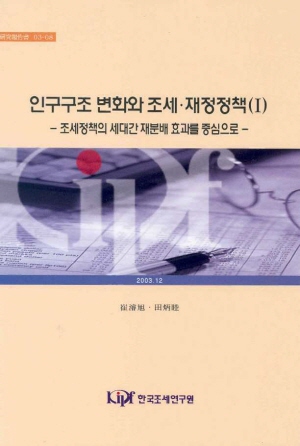인구구조 변화와 조세 재정정책(Ⅰ)
-조세정책의 세대간 재분배 효과를 중심으로-
- Keyword
- 고령화, 고령화, 공적연금, 건강보험, 공공지출, 공공지출, 건강보험, 공적연금
- Title
- 인구구조 변화와 조세 재정정책(Ⅰ)
-조세정책의 세대간 재분배 효과를 중심으로-
Fiscal Implications of Aging and Inter-generational Redistributive Effects of Fiscal Policy
- Authors
- Joonook Choi; Joonook Choi; Byung Mok Jeon; Byung Mok Jeon; 최준욱; 전병목
- Issue Date
- 2003-12-01
2003-12-01
- Publisher
- KIPF
KIPF
- Page
- pp. 190
pp. 190
- Abstract
- 본 연구에서는 우리나라에서 향후 인구구조의 고령화가 재정에 어떤 영향을 미치는지를 전망하고, 인구구조의 변화와 관련하여 제기되는 조세 및 재정정책의 세대간 재분배 효과에 대해 고찰한다. 고령화가 재정에 미치는 영향에 대해서는 향후 예상되는 인구구조의 변화를 명시적으로 감안하여, 공적연금, 건강보험, 노인복지 및 교육지출 등에서의 변화를 검토한다. 향후 고령화로 인해 GDP 대비 공공지출 비중이 크게 증가할 것으로 전망되는 바, 이와 관련된 정책 논의도 포함한다.
향후 공공지출 증가에서 가장 큰 부분을 차지하는 것이 공적연금 및 건강보험 지출인데, 이러한 제도는 세대간 재분배 효과를 초래할 수 있다. 이에 공적연금과 건강보험이 어떠한 세대간 재분배 효과를 초래하는지, 그리고 그러한 지출의 재원조달 방안에 따라 세대간 재분배 효과가 어떻게 달라질 수 있는지를 세대간 회계 방법을 이용하여 검토한다.
우리나라의 공적연금은 구조적인 문제 및 인구구조의 변화로 인해 미래세대로부터 현세대로 자원을 재분배하는 효과를 가진다. 그러한 효과는 공적연금 지출에 필요한 추가적인 재원을 어떻게 조달하는가에 따라 달라질 수 있으므로, 그것을 연금기여금 인상 대신 부가가치세나 소득세 등으로 조달하는 경우에는 세대별 세부담이 어느 정도 달라지는지를 검토한다. 그리고 세대간 재분배 효과에 대해 검토한 내용이 공적연금의 개혁과 관련하여 가지는 시사점 등에 대해 간략하게 논의한다.
건강보험의 세대간 재분배 효과는 인구구조의 변화는 물론이고 건강보험 지출의 향후 지출전망치, 급여구조의 변화, 재원조달 방안 등에 따라 달라진다. 현실성 있는 지출전망치를 이용하여 건강보험의 세대간 재분배 효과를 고찰하고, 급여구조의 변화 등에 따라 세대간 재분배 효과가 어떻게 달라지는지를 검토한다. 현재의 건강보험 지출 및 수입구조가 미래세대로부터 현세대로 자원을 재분배하는 효과를 가지고 있는 바, 건강보험 지출의 재원을 소비세 등으로 전환함으로써 기존의 세대간 재분배 효과를 어느 정도 상쇄할 수 있는지 등에 대해 검토한다.
This report studies (1) fiscal implications of aging, and (2) inter-generational redistributive effects of fiscal policy in Korea. Studies on fiscal implications of aging include long term projections in public pensions, National Health Insurance(NHI), welfare spending on elderly, and education. We also include discussion on fiscal policy implications of a rise in public spending.
Public pensions and NHI, two biggest components of government spending in the future, can cause redistribution of resources across generations. Hence, in this report, by using generational accounting method, potential inter-generational redistributive effects of the two systems are explicitly analysed. The study also includes analysis of how such redistributive effects depend on the method of financing the expenditure.
Korea’s current public pensions can redistribute resources from future generations to the current generation. Since such redistributive potential depends on how the expenditure is financed, this study explicitly compares the tax burden of each cohort under different regimes of financing : financing with consumption tax, financing with income tax, in addition to the current regime of financing with pension contributions. We also include policy discussion on the reform of public pensions from the perspective of generational justice.
Potential for inter-generational redistribution of NHI depends on demographic changes, future projections of expenditure, spending structure among different age-groups, and method of financing. It turns out that, with most realistic assumptions, NHI redistributes resources from future generations to the current generation. If such effects becomes strong due changes in other factors, replacing the current insurance premium with general consumption tax can mitigate the inter-generational redistributive effects of NHI substantially.
,
- Keywords
- 고령화, 고령화, 공적연금, 건강보험, 공공지출, 공공지출, 건강보험, 공적연금
